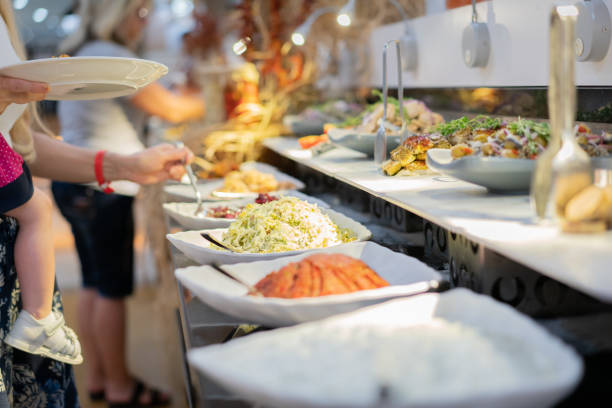All-you-can-eat (AYCE) buffets have long been a favorite choice for diners seeking an array of culinary options without breaking the bank. However, the economics behind these establishments often appear baffling. How do they manage to sustain themselves when customers can consume more than they paid for? In this article, we’ll uncover the hidden strategies and economic principles that enable AYCE buffets not only to survive but thrive in a competitive restaurant industry.
Defying Economic Theory
AYCE buffets face a daunting economic challenge known as “adverse selection.” According to this theory, businesses can suffer uncontrollable losses for every customer they serve. Buffets seem particularly susceptible to this risk since patrons can potentially eat more than what they paid for. However, several tactics help these establishments manage this risk effectively.
Streamlined Overhead
One key advantage AYCE buffets have over traditional restaurants is their reduced overhead costs. By placing customers in control of serving themselves and, in some cases, even getting their own drinks, buffets eliminate the need for a substantial waitstaff, thereby saving on labor expenses. The absence of elaborate plating and presentation also allows for cost-effective staffing. Additionally, many buffet dishes are prepped in advance, reducing the need for a large kitchen crew. In some AYCE buffets, customers even take on the role of cooks, further minimizing labor costs.
Strategic Food Costs
Food costs play a pivotal role in any restaurant’s profitability, and AYCE buffets are no exception. While typical food costs for a restaurant meal are around 30-35% of the menu price, buffets manage their risk by relying on a standard percentage to base their pricing. Even if an individual consumes more than the average estimate, it doesn’t result in losses for the buffet since their pricing accounts for the overhead and profit. Variations in customer consumption levels are absorbed by this pricing strategy, ensuring the restaurant remains profitable.
Minimizing Waste
To combat food waste and optimize their menu, buffet operators closely monitor customer consumption patterns. They analyze data to determine which items are popular and when, enabling them to plan their offerings accordingly. By utilizing smaller pans and transitioning to pre-portioned items, buffets also manage waste and reduce costs, thereby enhancing their profitability.
Economical Ingredients
Buffets follow a strategy known as “fill the customer’s belly cheaply.” They prioritize using versatile, low-cost ingredients, such as vegetables, which can be purchased in bulk. These ingredients can be creatively incorporated into various dishes, allowing buffets to offer a wide variety of options while controlling costs. This approach appeals to health-conscious customers, ensuring they find ample choices without significantly impacting the restaurant’s expenses.
Seasonal and Regional Specialties
Buffets embrace seasonal and regional foods for two reasons. First, seasonal ingredients are cost-effective when purchased in bulk, providing a financial advantage. Second, emphasizing locally-sourced and seasonal items allows buffets to present a unique and appealing menu, attracting customers and fostering loyalty.
Profitable Beverages
Beverages, which are typically not included in the buffet price, offer a substantial source of revenue for AYCE buffets. These establishments apply high markups to beverages, often exceeding 90%, further bolstering their profitability. The absence of self-serve drink stations and the presence of drink attendants limit refills, making it a lucrative endeavor for buffets.
Smaller Tools, Smaller Portions
Buffets strategically provide customers with smaller plates, bowls, and utensils, limiting the quantity of food that can be taken in a single trip. While patrons can make multiple trips, the inconvenience of requesting additional silverware discourages excessive consumption, ultimately increasing the restaurant’s profits.
Layout Design
The layout of AYCE buffets is meticulously planned to maximize profits. In most cases, the cheapest ingredients, such as salads and vegetables, are placed at the beginning of the buffet line, enticing customers to fill up on these items first. Costlier meats and seafood are usually located further down the line, making them less accessible. Additionally, the method of serving encourages customers to take less expensive items in smaller quantities, while cheaper dishes are served in larger quantities, creating a subtle incentive for moderation.
Pricing Psychology
AYCE buffets often follow a pricing strategy that defies conventional wisdom. While lower prices might attract more customers, a slightly higher but still reasonable price tends to result in greater customer satisfaction and loyalty. The Cornell Food and Brand Lab conducted an experiment revealing that customers who paid more were more satisfied with their experience and more likely to return, emphasizing the long-term benefits of charging slightly higher prices.
The economics of AYCE buffets, though seemingly counterintuitive, are built on a carefully orchestrated combination of pricing strategies, cost-effective ingredients, and customer psychology. By controlling overhead costs, minimizing waste, and optimizing menu offerings, these restaurants manage to not only survive but prosper in a competitive culinary landscape.
